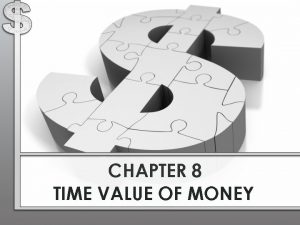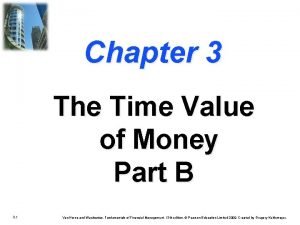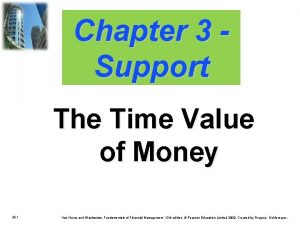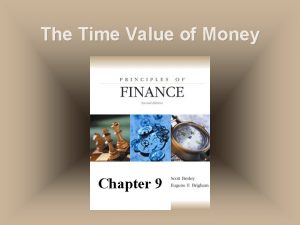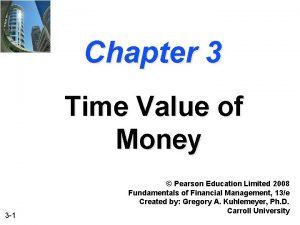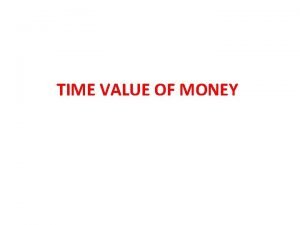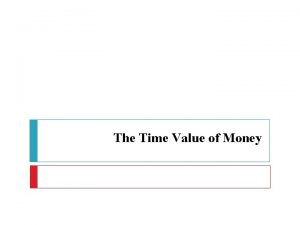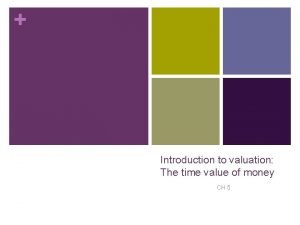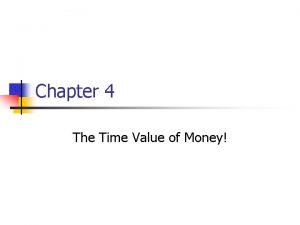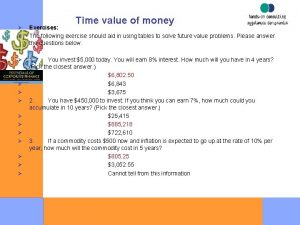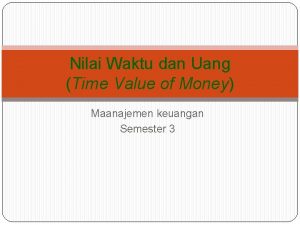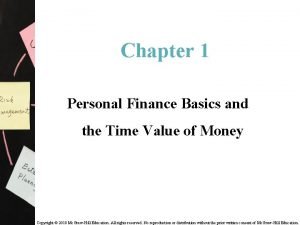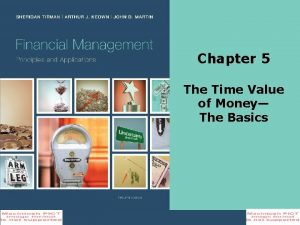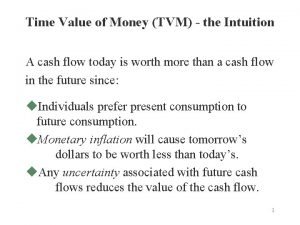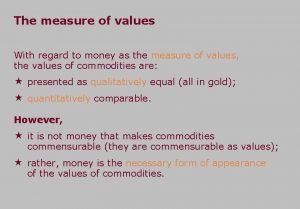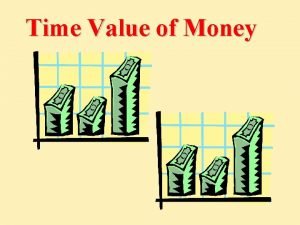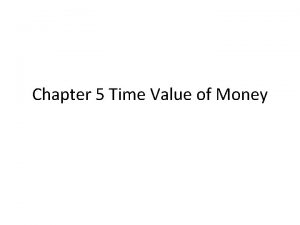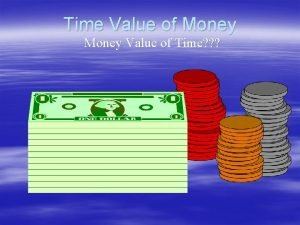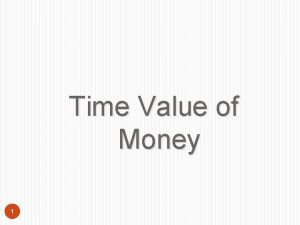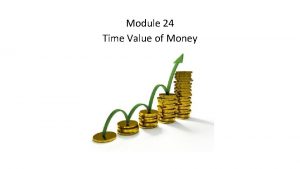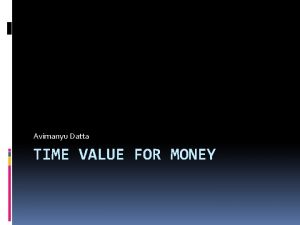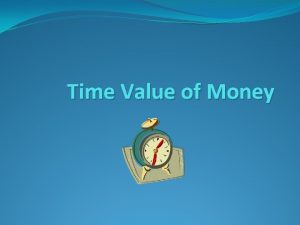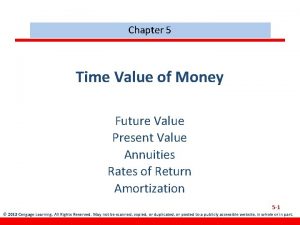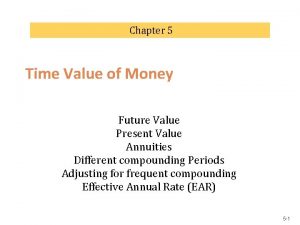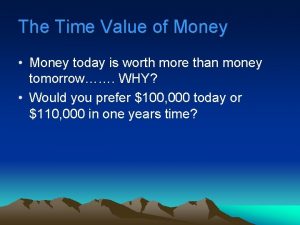Chapter 3 Support The Time Value of Money










![Present Value Excel Formula [Calculates a single current value based on future expectations] • Present Value Excel Formula [Calculates a single current value based on future expectations] •](https://slidetodoc.com/presentation_image/20f66b51ddb28ae7d9b97e6ee72288e7/image-11.jpg)











![Present Value of an Annuity [Calculates a single current value based on future expectations] Present Value of an Annuity [Calculates a single current value based on future expectations]](https://slidetodoc.com/presentation_image/20f66b51ddb28ae7d9b97e6ee72288e7/image-23.jpg)





![Future Value of an Annuity [Calculates a single current value based on future expectations] Future Value of an Annuity [Calculates a single current value based on future expectations]](https://slidetodoc.com/presentation_image/20f66b51ddb28ae7d9b97e6ee72288e7/image-29.jpg)

















- Slides: 46

Chapter 3 Support The Time Value of Money 3 b. 1 Van Horne and Wachowicz, Fundamentals of Financial Management, 13 th edition. © Pearson Education Limited 2009. Created by Gregory Kuhlemeyer.

Remember? Future Value Single Deposit (Graphic) Assume that you deposit $1, 000 at a compound interest rate of 7% for 2 years 0 7% 1 2 $1, 000 FV 2 3 b. 2 Van Horne and Wachowicz, Fundamentals of Financial Management, 13 th edition. © Pearson Education Limited 2009. Created by Gregory Kuhlemeyer.

Future Value Excel Formula [Calculates a single value in the future based on current expectations] • Excel function is =FV(rate, nper, pmt, pv, type) • rate: the interest rate period • nper: the total number of compounding periods • pmt: the payment made each period and cannot change over the life of the annuity ($0 in a single cash flow) • pv: the present value you begin with • type: is the number 0 (normal period-end) or 1 (beginning of the period) and indicates when payments are due/occur 3 b. 3 Van Horne and Wachowicz, Fundamentals of Financial Management, 13 th edition. © Pearson Education Limited 2009. Created by Gregory Kuhlemeyer.

Future Value Example Students may refer to the supporting Excel file for Chapter 3 (VW 13 E 03. xlsx) to use in developing their own solutions to other present value problems on the “Future Value” tab. Students may find this much easier! 3 b. 4 Van Horne and Wachowicz, Fundamentals of Financial Management, 13 th edition. © Pearson Education Limited 2009. Created by Gregory Kuhlemeyer.

Story Problem Revisited Julie Miller wants to know how large her deposit of $10, 000 today will become at a compound annual interest rate of 10% for 5 years 0 10% 1 2 3 4 5 $10, 000 FV 5 3 b. 5 Van Horne and Wachowicz, Fundamentals of Financial Management, 13 th edition. © Pearson Education Limited 2009. Created by Gregory Kuhlemeyer.

Future Value Example Refer to the supporting Excel file for Chapter 3 (VW 13 E-03. xlsx) on the “Future Value” tab. This is the identical answer as our other methods in one formula shown in the boxed area above! 3 b. 6 Van Horne and Wachowicz, Fundamentals of Financial Management, 13 th edition. © Pearson Education Limited 2009. Created by Gregory Kuhlemeyer.

Another Future Value Story Problem • John and Mary are saving for retirement and currently have $127, 833. 56 as a nest egg. • John indicates that they plan to retire 25 years from today while Mary expects that a 6% rate of return is appropriate for their risk level given historical returns. • Calculate how large the account is expected to grow. 3 b. 7 Van Horne and Wachowicz, Fundamentals of Financial Management, 13 th edition. © Pearson Education Limited 2009. Created by Gregory Kuhlemeyer.

“New” FV Story Problem Refer to the supporting Excel file for Chapter 3 (VW 13 E-03. xlsx) on the “Future Value” tab. 3 b. 8 Van Horne and Wachowicz, Fundamentals of Financial Management, 13 th edition. © Pearson Education Limited 2009. Created by Gregory Kuhlemeyer.

“New” FV Story Problem • John and Mary will have their $ 127, 833. 56 investment grow to $ 548, 645. 11 in 25 years if they earn exactly 6% each year. • Note that the Excel answer is a ‘positive’ amount. This indicates that John and Mary DEPOSITED $ 127, 833. 56 (the negative amount as they have less cash) to receive the positive $548, 645. 11 (when they receive cash at retirement when they WITHDRAW the funds). 3 b. 9 Van Horne and Wachowicz, Fundamentals of Financial Management, 13 th edition. © Pearson Education Limited 2009. Created by Gregory Kuhlemeyer.

Remember? Present Value Single Deposit (Graphic) Assume that you need $1, 000 in 2 years. Let’s examine the process to determine how much you need to deposit today at a discount rate of 7% compounded annually. 0 7% 1 2 $1, 000 PV 0 3 b. 10 PV 1 Van Horne and Wachowicz, Fundamentals of Financial Management, 13 th edition. © Pearson Education Limited 2009. Created by Gregory Kuhlemeyer.
![Present Value Excel Formula Calculates a single current value based on future expectations Present Value Excel Formula [Calculates a single current value based on future expectations] •](https://slidetodoc.com/presentation_image/20f66b51ddb28ae7d9b97e6ee72288e7/image-11.jpg)
Present Value Excel Formula [Calculates a single current value based on future expectations] • Excel function is =PV(rate, nper, pmt, fv, type) • rate: the interest rate period • nper: the total number of discounted periods • pmt: the payment made each period and cannot change over the life of the annuity ($0 in a single cash flow) • fv: the future value you expect to attain • type: is the number 0 (normal period-end) or 1 (beginning of the period) and indicates when payments are due/occur 3 b. 11 Van Horne and Wachowicz, Fundamentals of Financial Management, 13 th edition. © Pearson Education Limited 2009. Created by Gregory Kuhlemeyer.

Present Value Example Students may refer to the supporting Excel file for Chapter 3 (VW 13 E 03. xlsx) to use in developing their own solutions to other present value problems on the “Present Value” tab. Students may find this much easier! 3 b. 12 Van Horne and Wachowicz, Fundamentals of Financial Management, 13 th edition. © Pearson Education Limited 2009. Created by Gregory Kuhlemeyer.

Story Problem Revisited Julie Miller wants to know how large of a deposit to make so that the money will grow to $10, 000 in 5 years at a discount rate of 10%. 0 10% 1 2 3 4 5 $10, 000 PV 0 3 b. 13 Van Horne and Wachowicz, Fundamentals of Financial Management, 13 th edition. © Pearson Education Limited 2009. Created by Gregory Kuhlemeyer.

Present Value Example Students may refer to the supporting Excel file for Chapter 3 (VW 13 E 03. xlsx) to use in developing their own solutions to other present value problems on the “Present Value” tab. Students may find this much easier! 3 b. 14 Van Horne and Wachowicz, Fundamentals of Financial Management, 13 th edition. © Pearson Education Limited 2009. Created by Gregory Kuhlemeyer.

Another Present Value Story Problem • John and Mary are expecting to build a $100, 000 nest egg to use to travel the world upon retirement. They would like to know how much they need to set aside today to reach this goal. • John indicates that they will retire 20 years from today while Mary thinks that a 6% rate of return is appropriate for their risk level. Calculate how much they need to set aside today. 3 b. 15 Van Horne and Wachowicz, Fundamentals of Financial Management, 13 th edition. © Pearson Education Limited 2009. Created by Gregory Kuhlemeyer.

“New” PV Story Problem Students may refer to the supporting Excel file for Chapter 3 (VW 13 E 03. xls) to use in developing their own solutions to other present value problems on the “Present Value” tab. 3 b. 16 Van Horne and Wachowicz, Fundamentals of Financial Management, 13 th edition. © Pearson Education Limited 2009. Created by Gregory Kuhlemeyer.

“New” PV Story Problem • John and Mary need to set aside $31, 180. 47 today if they earn exactly 6% each year for the next 20 years to reach their goal. • Note that the Excel answer is a ‘negative’ amount. This indicates that John and Mary will need to DEPOSIT this amount of money (they have less cash) to receive the positive $100, 000 (when they receive cash) they would WITHDRAW monies. 3 b. 17 Van Horne and Wachowicz, Fundamentals of Financial Management, 13 th edition. © Pearson Education Limited 2009. Created by Gregory Kuhlemeyer.

Remember? Double Your Money!!! Quick! How long does it take to double $5, 000 at a compound rate of 12% per year (approx. )? We will use the “Rule-of-72”. 3 b. 18 Van Horne and Wachowicz, Fundamentals of Financial Management, 13 th edition. © Pearson Education Limited 2009. Created by Gregory Kuhlemeyer.

Output: The Periods! Students may refer to the supporting Excel file for Chapter 3 (VW 13 E 03. xlsx) to use in developing their own solutions to other interest rate problems on the “Periods” tab. Students may find this much easier! NOTE: The same answer! Solved in only one cell in Excel!! 3 b. 19 Van Horne and Wachowicz, Fundamentals of Financial Management, 13 th edition. © Pearson Education Limited 2009. Created by Gregory Kuhlemeyer.

Remember? Double Your Money!!! What if you were given the periods (years) and wanted to solve for the interest rate? Wouldn’t it be the same concept for the rule of 72? Yes! We simply need to solve using a different function in Excel called “rate”. 3 b. 20 Van Horne and Wachowicz, Fundamentals of Financial Management, 13 th edition. © Pearson Education Limited 2009. Created by Gregory Kuhlemeyer.

Output: The Interest Rate! Students may refer to the supporting Excel file for Chapter 3 (VW 13 E 03. xlsx) to use in developing their own solutions to other interest rate problems on the “Rate” tab. Note that we “guessed 12% as 12 x 6 = 72. The answer was very close! 3 b. 21 Van Horne and Wachowicz, Fundamentals of Financial Management, 13 th edition. © Pearson Education Limited 2009. Created by Gregory Kuhlemeyer.

Remember? Example of an Ordinary Annuity -- PVA Cash flows occur at the end of the period 0 $934. 58 $873. 44 $816. 30 1 7% $1, 000 $2, 624. 32 = PVA 3 2 3 $1, 000 PVA 3 = 4 $1, 000/(1. 07)1 + $1, 000/(1. 07)2 + $1, 000/(1. 07)3 = $934. 58 + $873. 44 + $816. 30 = $2, 624. 32 3 b. 22 Van Horne and Wachowicz, Fundamentals of Financial Management, 13 th edition. © Pearson Education Limited 2009. Created by Gregory Kuhlemeyer.
![Present Value of an Annuity Calculates a single current value based on future expectations Present Value of an Annuity [Calculates a single current value based on future expectations]](https://slidetodoc.com/presentation_image/20f66b51ddb28ae7d9b97e6ee72288e7/image-23.jpg)
Present Value of an Annuity [Calculates a single current value based on future expectations] • Excel function is =PV(rate, nper, pmt, fv, type) • rate: the interest rate period • nper: the total number of payments or periods • pmt: the payment that is made/received each period and cannot change over the life of the annuity • fv: a single future value you expect to receive (can be $0) • type: is the number 0 (normal period-end) or 1 (beginning of the period) and indicates when payments are due/occur 3 b. 23 Van Horne and Wachowicz, Fundamentals of Financial Management, 13 th edition. © Pearson Education Limited 2009. Created by Gregory Kuhlemeyer.

PV Annuity Example (Ordinary Annuity) Students may refer to the supporting Excel file for Chapter 3 (VW 13 E 03. xlsx) to use in developing their own solutions to other present value problems on the “PV Annuity” tab. Students will find this much easier! 3 b. 24 Van Horne and Wachowicz, Fundamentals of Financial Management, 13 th edition. © Pearson Education Limited 2009. Created by Gregory Kuhlemeyer.

“New” PV Annuity Example (Ordinary Annuity) • John and Mary are trying to build a nest egg to use in the future. They would like to know how much they need to set aside in a single lump sum today to be equivalent to investing $10, 000 each year starting one year from today to reach this goal. • John indicates that they will use the money 20 years from today while Mary thinks that a 6% rate of return is appropriate for their risk level. • Calculate the equivalent present value of this ordinary annuity stream. 3 b. 25 Van Horne and Wachowicz, Fundamentals of Financial Management, 13 th edition. © Pearson Education Limited 2009. Created by Gregory Kuhlemeyer.

“New” PV Annuity Example (Ordinary Annuity) Students may refer to the supporting Excel file for Chapter 3 (VW 13 E 03. xlsx) to use in developing their own solutions to other present value problems on the “PV Annuity” tab. Students will find this much easier! 3 b. 26 Van Horne and Wachowicz, Fundamentals of Financial Management, 13 th edition. © Pearson Education Limited 2009. Created by Gregory Kuhlemeyer.

“New” PV Annuity Example (Ordinary Annuity) • John and Mary need to set aside $127, 833. 56 today to be equivalent to setting aside $10, 000 per year at exactly 6% each year for the next 25 years. • In this case, John and Mary need to decide which is their preference. This sum will grow to exactly the same as the future value of an ordinary annuity (see slides 7 to 9). 3 b. 27 Van Horne and Wachowicz, Fundamentals of Financial Management, 13 th edition. © Pearson Education Limited 2009. Created by Gregory Kuhlemeyer.

Remember? Example of an Ordinary Annuity -- FVA Cash flows occur at the end of the period 0 1 2 3 $1, 000 4 7% $1, 000 $1, 070 $1, 145 FVA 3 = $1, 000(1. 07)2 + $1, 000(1. 07)1 + $1, 000(1. 07)0 $3, 215 = FVA 3 = $1, 145 + $1, 070 + $1, 000 = $3, 215 3 b. 28 Van Horne and Wachowicz, Fundamentals of Financial Management, 13 th edition. © Pearson Education Limited 2009. Created by Gregory Kuhlemeyer.
![Future Value of an Annuity Calculates a single current value based on future expectations Future Value of an Annuity [Calculates a single current value based on future expectations]](https://slidetodoc.com/presentation_image/20f66b51ddb28ae7d9b97e6ee72288e7/image-29.jpg)
Future Value of an Annuity [Calculates a single current value based on future expectations] • Excel function is = FV(rate, nper, pmt, pv, type) • rate: the interest rate period • nper: the total number of payments or periods • pmt: the payment that is made/received each period and cannot change over the life of the annuity • pv: a single present amount you begin with (can be $0) • type: is the number 0 (normal period-end) or 1 (beginning of the period) and indicates when payments are due/occur 3 b. 29 Van Horne and Wachowicz, Fundamentals of Financial Management, 13 th edition. © Pearson Education Limited 2009. Created by Gregory Kuhlemeyer.

Future Value Annuity Example (Ordinary Annuity) Students may refer to the supporting Excel file for Chapter 3 (VW 13 E 03. xlsx) to use in developing their own solutions to other present value problems on the “FV Annuity” tab. The same answer as before is arrived at in a single step in Excel - one formula ‘=FV(. 07, 3, -1000, 0, 0)’! 3 b. 30 Van Horne and Wachowicz, Fundamentals of Financial Management, 13 th edition. © Pearson Education Limited 2009. Created by Gregory Kuhlemeyer.

“New” Future Value Annuity Example (Ordinary Annuity) • John and Mary are trying to build a nest egg to use in the future. They would like to know how much they need to set aside in a single lump sum today to be equivalent to investing $10, 000 each year starting one year from today to reach this goal. (See slides 21 to 23 and also 7 to 9) • John indicates that they will use the money 20 years from today while Mary thinks that a 6% rate of return is appropriate for their risk level. • Calculate the equivalent present value of this ordinary annuity stream. 3 b. 31 Van Horne and Wachowicz, Fundamentals of Financial Management, 13 th edition. © Pearson Education Limited 2009. Created by Gregory Kuhlemeyer.

“New” Future Value Annuity Example (Ordinary Annuity) Students may refer to the supporting Excel file for Chapter 3 (VW 13 E-03. xlsx) to use in developing their own solutions to other present value problems on the “FV Annuity” tab. Students will find this is the exact same answer as those derived using PV of an annuity and then Future Value! 3 b. 32 Van Horne and Wachowicz, Fundamentals of Financial Management, 13 th edition. © Pearson Education Limited 2009. Created by Gregory Kuhlemeyer.

“New” Future Value Annuity Example (Ordinary Annuity) • John and Mary will accumulate nearly $550, 000 by investing $10, 000 per year at exactly 6% each year for the next 25 years. • In this case, note that this result is equivalent to the future value of a single sum where John and Mary needed to set aside over $127, 000 to generate this sum. 3 b. 33 Van Horne and Wachowicz, Fundamentals of Financial Management, 13 th edition. © Pearson Education Limited 2009. Created by Gregory Kuhlemeyer.

Remember? Example of an Annuity Due – PVAD Cash flows occur at the beginning of the period 0 1 2 $1, 000 3 4 7% $1, 000. 00 $ 934. 58 $ 873. 44 $2, 808. 02 = PVADn = $1, 000/(1. 07)0 + $1, 000/(1. 07)1 + $1, 000/(1. 07)2 = $2, 808. 02 3 b. 34 Van Horne and Wachowicz, Fundamentals of Financial Management, 13 th edition. © Pearson Education Limited 2009. Created by Gregory Kuhlemeyer.

PV Annuity Example (Annuity Due) Students may refer to the supporting Excel file for Chapter 3 to use in developing their own solutions to other present value annuity problems. 3 b. 35 Van Horne and Wachowicz, Fundamentals of Financial Management, 13 th edition. © Pearson Education Limited 2009. Created by Gregory Kuhlemeyer.

“New” PV Annuity Example (Annuity Due) • John and Mary are trying to build a nest egg to use in the future. They would like to know how much they need to set aside in a single lump sum today to be equivalent to investing $10, 000 each year starting today to reach this goal. • John indicates that they will use the money 25 years from today while Mary thinks that a 6% rate of return is appropriate for their risk level. • Calculate the equivalent present value of this annuity due stream. 3 b. 36 Van Horne and Wachowicz, Fundamentals of Financial Management, 13 th edition. © Pearson Education Limited 2009. Created by Gregory Kuhlemeyer.

“New” PV Annuity Example (Annuity Due) Students may refer to the supporting Excel file for Chapter 3 to use in developing their own solutions to other present value annuity problems. 3 b. 37 Van Horne and Wachowicz, Fundamentals of Financial Management, 13 th edition. © Pearson Education Limited 2009. Created by Gregory Kuhlemeyer.

“New” PV Annuity Example (Annuity Due) • John and Mary need to set aside $135, 503. 58 today to be equivalent to setting aside $10, 000 per year at exactly 6% each year for the next 25 years. • In this case, John and Mary need to decide which is their preference. This sum will grow to exactly the same as the future value of an ordinary annuity (see slides 24 to 26) plus EXTRA interest. • EXTRA INTEREST: So the amount is one years interest higher for each payment or $127, 833. 56*6% = $7, 670. 01 higher PV! 3 b. 38 Van Horne and Wachowicz, Fundamentals of Financial Management, 13 th edition. © Pearson Education Limited 2009. Created by Gregory Kuhlemeyer.

Annuity Due • An annuity due is used when the cash flow occurs at the beginning of the period • As before, you see the value is higher by an amount equal to i% times the ordinary annuity value. • Present values of annuities will be larger because each cash flow is “discounted” one less period. See previous examples. • Future values of annuities will be larger because each cash flow gets compounded one “extra” period. No examples shown here. 3 b. 39 Van Horne and Wachowicz, Fundamentals of Financial Management, 13 th edition. © Pearson Education Limited 2009. Created by Gregory Kuhlemeyer.

Mixed Flows Example Julie Miller will receive the set of cash flows below. What is the Present Value at a discount rate of 10% 0 1 10% $600 2 3 4 5 $600 $400 $100 PV 0 3 b. 40 Van Horne and Wachowicz, Fundamentals of Financial Management, 13 th edition. © Pearson Education Limited 2009. Created by Gregory Kuhlemeyer.

Solve a “mixed flows” problem using the NPV function Students may refer to the supporting Excel file for Chapter 3 (VW 13 E 03. xlsx) to use in developing their own solutions to other present value problems on the “Mixed Flows” tab. Simply type in the cash flows in the green column and the correct interest rate in yellow and you get your answer! 3 b. 41 Period 1 2 3 4 5 6 7 8 9 10 11 12 13 14 15 16 17 18 19 20 Cash Flows $ 600. 00 $ 400. 00 $ 100. 00 Interest Rate: (discount rate) 10% Present Value*: $1, 677. 15 =NPV(F 3, C 3: C 22) * Do NOT include cash flows in period 0. Please add or subtract these flows from the final answer above. (Cell F 6) Van Horne and Wachowicz, Fundamentals of Financial Management, 13 th edition. © Pearson Education Limited 2009. Created by Gregory Kuhlemeyer.

Solve a “mixed flows” problem using the NPV function Students can also solve this in one formula step again! =npv(. 10, 600, 400, 100) This will generate the same and correct output. The model on the right is designed to be slightly more flexible in solving these types of problems. Remember the NPV function, because we will use it later! 3 b. 42 Period 1 2 3 4 5 6 7 8 9 10 11 12 13 14 15 16 17 18 19 20 Cash Flows $ 600. 00 $ 400. 00 $ 100. 00 Interest Rate: (discount rate) 10% Present Value*: $1, 677. 15 =NPV(F 3, C 3: C 22) * Do NOT include cash flows in period 0. Please add or subtract these flows from the final answer above. (Cell F 6) Van Horne and Wachowicz, Fundamentals of Financial Management, 13 th edition. © Pearson Education Limited 2009. Created by Gregory Kuhlemeyer.

Remember? BWs Effective Annual Interest Rate Basket Wonders (BW) has a $1, 000 CD at the bank. The interest rate is 6% compounded quarterly for 1 year. What is the Effective Annual Interest Rate (EAR)? EAR = ( 1 + 6% / 4 )4 - 1 = 1. 0614 - 1 =. 0614 or 6. 14%! 3 b. 43 Van Horne and Wachowicz, Fundamentals of Financial Management, 13 th edition. © Pearson Education Limited 2009. Created by Gregory Kuhlemeyer.

BWs Effective Annual Interest Rate We can use a single function in Excel again to solve for the Effective Annual Interest Rate (EAR) EAR Nominal 6% 6% Periods 1 2 4 6 12 365 1, 000 Effective 6. 0000% 6. 0900% 6. 1364% 6. 1520% 6. 1678% 6. 1831% 6. 1837% Formula Used =EFFECT(B 3, C 3) =EFFECT(B 4, C 4) =EFFECT(B 5, C 5) =EFFECT(B 6, C 6) =EFFECT(B 7, C 7) =EFFECT(B 8, C 8) =EFFECT(B 9, C 9) So it is very simple to solve for the effective rate using Excel. Note that a large number of periods per year can be used to approximate continuous compounding! 3 b. 44 Van Horne and Wachowicz, Fundamentals of Financial Management, 13 th edition. © Pearson Education Limited 2009. Created by Gregory Kuhlemeyer.

Remember? Amortizing a Loan Example Julie Miller is borrowing $10, 000 at a compound annual interest rate of 12%. Amortize the loan if annual payments are made for 5 years. Step 1: Payment PV 0 = R (PVIFA i%, n) $10, 000 = R (PVIFA 12%, 5) $10, 000 = R (3. 605) R = $10, 000 / 3. 605 = $2, 774 3 b. 45 Van Horne and Wachowicz, Fundamentals of Financial Management, 13 th edition. © Pearson Education Limited 2009. Created by Gregory Kuhlemeyer.

Remember? Amortizing a Loan Example 1. 2. The first step is to use the “PMT” function to determine the yearly (in this case) payment on the loan Now you can use Excel to easily create the table you see below! Refer to ‘VW 13 E-03. xlsx’ on the ‘Effect and Loan’ tab. Amortizing a loan Step 1: Calculating the loan amount ï Interest rate period (year in this case) Rate: 12. 00% ï Number of periods (5 years in this case) nper: 5 pv $ 10, 000. 00 ï Beginning loan balance today (positive) ï Ending loan balance at end of periods fv $ payment: ($2, 774. 10) ï Payment needed (negative) Step 2: Create a table Period Beginning Bal 0 1 $ 10, 000. 00 2 $ 8, 425. 90 3 $ 6, 662. 91 4 $ 4, 688. 37 5 $ 2, 476. 87 3 b. 46 Payment $2, 774. 10 Interest in Period $ $ $ 1, 200. 00 1, 011. 11 799. 55 562. 60 297. 22 Principal in Period $1, 574. 10 $1, 762. 99 $1, 974. 55 $2, 211. 49 $2, 476. 87 Ending Balance $ 10, 000. 00 $ 8, 425. 90 $ 6, 662. 91 $ 4, 688. 37 $ 2, 476. 87 $ 0. 00 Van Horne and Wachowicz, Fundamentals of Financial Management, 13 th edition. © Pearson Education Limited 2009. Created by Gregory Kuhlemeyer.
 Money money money team
Money money money team Chapter 8 time value of money answer key
Chapter 8 time value of money answer key Chapter 3 time value of money problem solutions
Chapter 3 time value of money problem solutions Chapter 3 time value of money problem solutions
Chapter 3 time value of money problem solutions Chapter 2 time value of money solutions
Chapter 2 time value of money solutions Chapter 3 time value of money problem solutions
Chapter 3 time value of money problem solutions Rumus anuitas
Rumus anuitas Objectives of time value of money
Objectives of time value of money Introduction to valuation the time value of money
Introduction to valuation the time value of money Time value of money quiz
Time value of money quiz Time value of money exercises
Time value of money exercises Anuitas adalah
Anuitas adalah Diskusi tentang time value of money
Diskusi tentang time value of money Personal finance basics and the time value of money
Personal finance basics and the time value of money Time value of money
Time value of money Time value of money
Time value of money Pengertian time value of money
Pengertian time value of money Value creation value delivery value capture
Value creation value delivery value capture Historical background of the great gatsby
Historical background of the great gatsby Money smart money match
Money smart money match Money on money multiple
Money on money multiple Old money vs new money
Old money vs new money Old money vs new money
Old money vs new money Start time, end time and elapsed time
Start time, end time and elapsed time Grammatical signals
Grammatical signals How to write 50 centavos
How to write 50 centavos Value of money meaning
Value of money meaning How to calculate future value of money
How to calculate future value of money Present and future value of money
Present and future value of money Internal value of money
Internal value of money Assessing value for money
Assessing value for money Money as a measure of value
Money as a measure of value Hình ảnh bộ gõ cơ thể búng tay
Hình ảnh bộ gõ cơ thể búng tay Ng-html
Ng-html Bổ thể
Bổ thể Tỉ lệ cơ thể trẻ em
Tỉ lệ cơ thể trẻ em Voi kéo gỗ như thế nào
Voi kéo gỗ như thế nào Thang điểm glasgow
Thang điểm glasgow Hát lên người ơi alleluia
Hát lên người ơi alleluia Các môn thể thao bắt đầu bằng từ đua
Các môn thể thao bắt đầu bằng từ đua Thế nào là hệ số cao nhất
Thế nào là hệ số cao nhất Các châu lục và đại dương trên thế giới
Các châu lục và đại dương trên thế giới Cong thức tính động năng
Cong thức tính động năng Trời xanh đây là của chúng ta thể thơ
Trời xanh đây là của chúng ta thể thơ Mật thư anh em như thể tay chân
Mật thư anh em như thể tay chân Phép trừ bù
Phép trừ bù độ dài liên kết
độ dài liên kết

